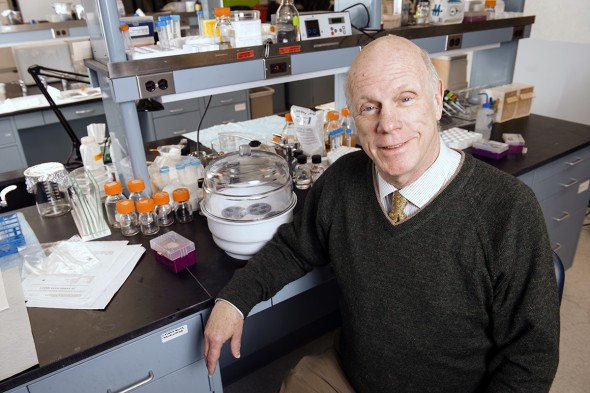Gaining neuron knowledge to fight ALS, Alzheimer’s

Scott Brady wants to understand the molecular biology of neurons. Photo: Roberta Dupuis-Devlin/UIC Photo Services
The University Scholar award, now in its 30th year, honors UIC faculty who are among the best in their fields — those who show superior performance and great promise in research and teaching. Winners receive $15,000 per year for three years.
Scott Brady wants to understand the cell and molecular biology of neurons: how they can get so large (as much as 1 meter or more long in humans), how materials get from one end of these long cells to the other, and how dysfunctions may underlie neurodegenerative diseases like ALS, Alzheimer’s, Parkinson’s and Huntington’s disease.
Right now, he’s looking at the transport of structures, proteins and signaling molecules along the cytoskeleton of nerve cells.
“When neurons don’t have the materials they need to function, they can lose contact with targets, whether other neurons or muscles,” says Brady, professor and head of anatomy and cell biology.
Neurons that lose connection with their target cells are programmed to die, Brady says. “Cell death is the final step in the lengthy neurodegenerative diseases like ALS, but we need to understand the earlier stages of disease, when treatments can make a difference.”
Brady and his colleagues have studied disease-causing proteins associated with a number of neurodegenerative diseases. For example, they found that mutations in a protein called SOD1, which cause about 10 percent of cases of inherited ALS, affect the motor proteins that move materials along nerve axons.
Using a technique that combines video and light microscopy, which allows him to observe the movement of materials in neurons, Brady saw that when he added the mutated protein to squid axons, transport slowed down. Following up on these studies, his laboratory identified how the mutant protein affects transport and nerve function. They found similar changes in Alzheimer’s and Huntington’s disease, each affecting a unique aspect of the neuron.
Brady also studied the stabilization of the neuronal cytoskeleton and the role of glial cells in supporting the architectural structure of neurons. His earlier work discovered a new kind of motor protein, kinesin, and showed that kinesin is the primary motor molecule for the transport of materials along microtubules in neurons.
In 2013, Brady was named a fellow of the American Association for the Advancement of Science. He is president-elect of the Association of Anatomy Cell Biology and Neurobiology Chairpersons. He received the Iron Horse award from the Chicago chapter of the ALS Association for his research into the causes of ALS.
